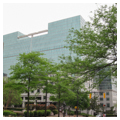The New York City firm of Kohn Pederson Fox became famous for an office tower in Chicago, 333 Wacker Drive, begun just a year before this Wilmington commission for a chemical company. Both projects raised expanses of blue-green glass against the sky. Postmodern contextualism called for bulky highrises to relate sympathetically to their historical surroundings, and here the glass tower rises from a lower section of stone, a false-front (complete with faux cornices) mimicking a series of older, discreet buildings. The firm followed an identical approach in a hotel on Logan Circle, Philadelphia (1979–1983). Rockville, Minnesota, granite was cut at a fabrication plant into two-inch-thick panels. The designers attempted to give the illusion of depth to the detailing, but it is nonetheless cold and mechanical compared to genuine nineteenth-century stonework. A hugely overscaled clock perched on a roofline offers a note of Postmodern whimsy. Inside the 680,000-square-foot, fourteen-story building is a towering atrium with a gridded framework in colors inspired by the Dutch artist Piet Mondrian. Soaring piers and globe lighting fixtures were derived from Frank Lloyd Wright's Larkin Building, Buffalo. Postmodernism was then new, and Hercules proved controversial. In an interview, the local architect Harley Funk, still committed to modernism, called it “an unfortunate building … arbitrary in a stylistic way, to have a glass box rising out of imitative eclectic stone fragments at the bottom” (Athan 1982). Across Market Street stands the Beneficial Building, with a curved corner, one of the first International Style structures in Wilmington (c. 1952, Walter Carlson).
You are here
Hercules Inc. Headquarters
If SAH Archipedia has been useful to you, please consider supporting it.
SAH Archipedia tells the story of the United States through its buildings, landscapes, and cities. This freely available resource empowers the public with authoritative knowledge that deepens their understanding and appreciation of the built environment. But the Society of Architectural Historians, which created SAH Archipedia with University of Virginia Press, needs your support to maintain the high-caliber research, writing, photography, cartography, editing, design, and programming that make SAH Archipedia a trusted online resource available to all who value the history of place, heritage tourism, and learning.









